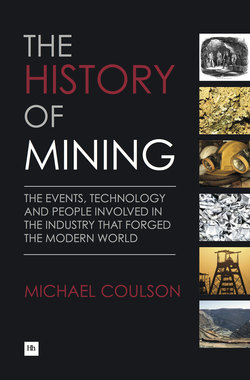Читать книгу The History of Mining - Michael Coulson - Страница 23
На сайте Литреса книга снята с продажи.
Rome’s Spanish mines
ОглавлениеAs well as gold, the Romans operated silver and lead mines around the same time in central Spain at Plasenzuela, Extremadura, for a period of around a hundred years. These mines do not appear to have been visited by Pliny so we must rely once more on the observations of archaeologists and the discoveries of the miners who operated the mines again in the second half of the 19th century. The dating of the Plasenzuela operations to Roman times relates to the toxicity of some of the residues on the site, which contain arsenic and come from smelting of the mine output, a sure sign of Roman involvement. Roman roof slate fragments were also found in the slag heaps. Investigation of some of the slag also suggested that the Romans had experimented with a process to try to recover some of the lead metal lost in the smelting process.
Much evidence has also been found of ancient mining in southwest Spain in Almeria in the Sierra Almagrera, which probably started in the 3rd millennium BC, and over the centuries carried out by a variety of visitors including the Phoenicians, the Romans and the Moors. The mines here produced lead and silver and though they were inactive for centuries during the Middle Ages they came back to life in the 19th century. Today mining is very small scale, carried out by individual entrepreneurial miners.
Another ancient mining site in Almeria was Rodalquila, where gold has been the target since Roman times. The Romans were also responsible for the development of the Ojos Negros iron mines in Teruel in the north of Spain, and of the giant mercury mines of Almeden Puertollano in Ciudad Real. Near Barcelona the mines of Gava were mined from around the 4th millennium BC for a green mineral called variscite that was probably used for making basic but colourful jewellery. Also from this period in Murcia in southeast Spain mining of iron, lead and zinc began and continued up until the 20th century.
Whilst Spain was both the Republic and the Empire’s most important provider of metals and minerals, Italy itself was a substantial source of raw materials, particularly of industrial minerals such as salt, stone and clay. Records are thin on Rome’s Italian mineral sources but according to Polybius rich gold deposits were found and worked at Aquileia at the top of the Adriatic, near what were to become the lagoons of Venice. The Republic also acquired the gold mines of the Alpine tribe, the Salassi, when they conquered the small territory which lies on the Italian side of the Alps in 138 BC. Sardinia, acquired by the Republic from Carthage in 238 BC, was also a substantial producer of silver, lead and iron ore.
